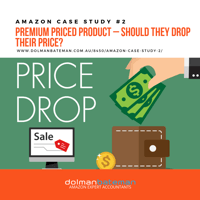Amazon Case Study - Competitive Intelligence
Links:
Transcript:
This weeks case study is how you can spy on your competition – learning from their mistakes and profiting from their successes.
We are going to look are the information that is readily available and go deep into the data.
Competitive Intelligence is the action of defining, gathering, analyzing and distributing intelligence
about products, customers, competitors and any aspect of the environment
needed to support executives and managers making strategic decisions for an organization.
Having an Amazon business is more than just your product and brand you need to know what is happening in the marketplace as well.
Amazon is a competitive dynamic marketplace.
People are always saying that Amazon is getting more competitive, more people coming in.
But after examining a number of markets – it appears that people are also leaving or are not successful as well.
They leave because they don’t have enough money to reinvest into the next shipment, they give up too early, they just never rank well enough to get organic sales.
When you are looking at your competitors, there are two groups, they fly by nighters and the consistent performers.
You want to be learning from the consistent performers and watching the mistakes of the fly by nighters.
Some Amazon Reporting Tools offer the option of tracking competitors – usually there is a limit for each pricing band.
But the problem is the competitors that you choose today but not be your competitor next month and new gun product, which you are not tracking, overtakes you and you have no data as to what they did. In fact, you might be in the mistaken belief that you are tracking the market but in fact you are really only tracking a small subset of the market.
I looked at some markets over a six month period:
Garlic press – of the 24 product on the first page in June 2016 only 15 were left by October – 4 months later. Of the second page in June none made it to the first page and only two remained on 2nd page.
Yoga Mat – 24 brands but only 16 brands remained after 6 months – only 2 ASIN remained. (Top Seller and Amazon Basics)
In a smaller less competitive niche, only 10 product survived from June to October. Of the 24 at October, 15 remained on top 24 by February.
So need to track all the competitors in your market rather than just a few.
Many of you already have the Jungle Scout Chrome extension, but most people just use it for product research and not for spying on their competitors once their products are up and running.
The Jungle Scout Chrome is a fantastic tool, it is a real game changer.
If you don’t have it, there is a link below.
Not long ago, the information that Jungle Scout provides would have cost businesses million to obtain.
It would have taken months to obtain the sales volume pricing and consumer opinions of all their competitors.
Not you can get that information in an instant.
Jungle Scout is great for product research but it has a far more powerful function which is competitor intelligence.
It doesn’t just track one competitor, it can track hundreds of your competitors for every keyword that you have.
Jungle Scout is the easiest and most efficient way to collect data on your competitors. It literally takes one minute – in fact the it is even quicker – just one click added to your daily ritual.
Lets talk a bit about how Jungle Scout works:
One, you do a search for a product on Amazon and it brings up the top 16 or 24 listings.
Two, you click the Jungle Scout icon in Chrome and Jungle Scout does it’s magic.
- It scans the page and gets the ASIN number of each product but not sponsored products.
- It collects from the page: Page Rank, Title, Brand, Price, Number of Reviews, Review Rating, and BSR – Best Seller Rank
- From the BSR or Best Seller Rank for the category, it uses the Jungle Scout algorithm to estimate the number of units sold.
The estimated sales is the really valuable feature of Jungle Scout – and it seems pretty accurate.
So Jungle Scout takes a snapshot of the market at that point of time, but the sales volume is based on the BSR which as you know moves around on an hourly basis.
And that can jump around significantly due to:
- Promotions
- Lightning deals
- Giveaways
- Outside influences (holidays, sale days black Friday, cyber monday, or what is happening in other unrelated niches within that category.
Need to collect the data,
Here is a simple system each morning.
1.Log into Seller Central.
2.Check sales overnight and yesterday?
3.Check for buyer messages
4.Check for Amazon Messages
5.Go to Amazon – search primary search terms for your products.
6.Click JungleScout and collect extra pages until your product or products show up.
7.Export CSV in Jungle Scout
A simple addition to your daily system. If you have a few products – your would probably do it yourself. If more then a job for your VA and they save it to a Google Drive.
It doesn’t matter if you don’t look at the data then, you have just saved a snapshot of your market at that point of time.
You have the data – so when you have to investigate an issue later you hhave the data.
Many Amazon reporting tools have a competitive intelligence function – track rankings or track competitrs but you usually are tracking a limited number and those compitotros might be the fly-by-nighters.
By using Jungle Scout and saving the data – it’s not fully automatic but you can track thousands of competitors across all your keywords.
So you need to look at the reports over time – to see the trends.
To do that you need to save the reports – Jungle Scout has a feature – “Export CSV”
Lets look at the first process of Researching a product:
- Use Amazon to search a product that fits your criteria:
- Price: High enough to make a sustainable profit and enough to buy advertising
- Depth of market: Enough demand for the product
- Number of Competitors: Is there a place where your product could fit it
- Number of reviews
So at that point using Jungle Scout you have found a product that could be an opportunity.
Hint: save the jungle scout report. Ill show you what to do with it later.
But at this stage, you are making some assumptions about the market and the opportunity at this time
You go to Alibaba or AliExpress or another manufacturer and search for the possible products that match.
You message back and forth with suppliers and you get some samples sent.
This process could take a week or a month before you get the samples to inspect.
You then see where you logo could go, suggest some amendments and get the supplier to send you new final samples.
You get the new final samples and are ready to place your order.
This process of deciding on a product to placing your first order could take between 1 month and 3 months depending upon your product.
During that time:
- There could have been a price war that decimates your margins
- More competitors enter the market
- Products changed – new features and an old style that is no longer selling.
- Products that you thought were competitors and people you could beat are no longer even ranked on the first page.
So you need to look at how things have changed over time – to see whether the assumptions that you made are still valid.
Lets look at the changes to the market for the term Garlic Press:
In June 2016 – The Depth of Market – Volume of Top 10 was 16,000 units per month by October that had fallen to 10,000 units per month.
The average price in the 4 months had fallen from $14.31 to $12.96. Whilst it’s only a drop of $1.35 or 9% drop it represents a fall of 35% in profits.
Out of the 48 products that were ranking for Garlic Press in June only 15 survived – the rest disappeared.
Price volume Scattergram – This is a really valuable graph – as it tells you instantly where everyone fits into the market.
We have the three top sellers charging more and selling more.
We can price elasticity whether volume responds to price. Whether two segments within market – high and low
Volume per month – this report shows a quick overview as a table. Total volume, volume from top 10 sellers, total volume from first page, total volume from second page.
Average volume – on average if on first page could sell 600 per month but the max is 2648 and the min is 90.
But this data gets really powerful when we look have data over time.
Don’t forget – Jungle Scout is just a snapshot and the volume and sales data are based on BSR which moves around several time during the day. A product could be showing as a winner in the morning and a loser in the afternoon.
When I am looking at financials, profit & loss sales data balance sheets for clients, I never just look at a single period – always looking for the trends.
What direction is the business heading. The more data that we have in order to make that decision the better, the less assumptions that we have to make, the more certain we are of the advice we provide, the decisions we make.
Example of Long Term Trends – Look at the history and trends over time.
This is search term that I have been tracking for a while – what if you made your assumptions when the product was conducting a lightning deal.
Tells us something else – how much product can we expect to sell in a lightning deal – given that there is now a fixed fee for lightning deal you need data as to what you could expect to sell in lightning deal. Your competitors can tell you that information. But need data to show – so need to download daily for primary keywords.
This is the current volume for a keyword we are tracking, from the Jungle Scout reports.
The blue bars are volume per product ranked by pagerank.
The competition and volume has been pretty stable. The volume graph has been similar for a while.
The shape of the graph is typical – top 3 products have most of the traffic.
The red line is what we would expect from organic growth – Google search graphs are similar.
But what we are looking for is the outliers. Two products in particular get more sales than you would expect from just organic traffic. Circled in Green
We see this across all markets – a couple of products seem to perform better than their immediate peers.
So what can we learn from this:
1.Is there something on their listing that is attracting more buyers – images, price Titles.
2.Are they getting traffic from another keyword that you might have missed. This is common especially where market is thin they might show another product that the buyers also buy.
3.Advertising – are they doing Sponsored Ads – Gives you an ideal as to potential volume.
4.Traffic from other sources – Are they directing traffic to Amazon?
1.Most brands do not direct traffic to Amazon and most have no internet marketing skills. So the outliers could provide clue to best practice.
2.What do you do?
1.Find their website – Join their mailing list, what is there email sequence, do they have a facebook pixel installed?
2.Go to Facebook – if in USA, do you see their ads appearing in your feed?
3.Find their Facebook page – Like it – what do they post – there is ideas for content.
4.Find other Social sites – Instagram, Pinterest, Twitter.
3.Buy their product? – what is their email followup like.
This also points to an interesting issue regarding page rank – if they are consistently selling more – if page rank was based on sales or sales velocity then they should be ranking at positions 4 & 5, but they don’t ?
My opinion is that the unit session percentage or conversion rate is less than the products ranking higher.
Lets have a look at how we can use the Jungle Scout data to locate the best practice in the industry.
We were just having a look at our reviews and if we could do better, but we had no idea whether we were doing well with reviews or poorly.
But the data was living in the Jungle Scout Reports – we were able to calculate the Review Rate (Number of Reviews per 100 sales).
Looked at the average sales for a product, divided by the increase in reviews divided by the number of months that we had data.
Now I could look at any market and find the best review system based on actual reviews can comparing products that sold thousands a month to ones that sold 100 per month.
Now the getting reviews is more organic now rather as the paid review systems that mostly ceased in October 2016. So the review data forward should reflect organic review growth.
It was interesting and you can make your own conclusions in your markets but it looks like many sellers have no review system in place at all.
This is part of the report for a highly competitive and dynamic market “yoga mat”
Because we have collected the data on this search term over about six months – its not a complete data set (Sept to Dec) is missing.
In Yoga Mats – BalanceFrom is the top ranked yoga mat consistently it does 4,000 to 5,000 units per month and has 3,812 reviews and a review rate of 2.3%.
If you look through the results for your market, you will see at 2.3% is pretty good.
If we looked at Reeehut the 2nd result it has 1.8%.
But the rest of the results for Yoga Mat are pretty low.
By clicking the green Graph icon we can see the history and we could see the reviews increasing consistently for both those products.
So what do we do with that information:
Time to buy a yoga mat on Amazon and pay close attention to the email sequence.
1.What messages did they send out.
2.What did those messages ask you to do?
3.When did they send them out?
4.How many messages did they send?
5.Did they direct to Seller first and then Product Reviews or straight to Product Reviews
6.Did they send a bonus? Was it a surprise or promised?
7.What language did they use, was it aimed at an particular avatar?
8.Is it within Amazon’s Terms of Service.




